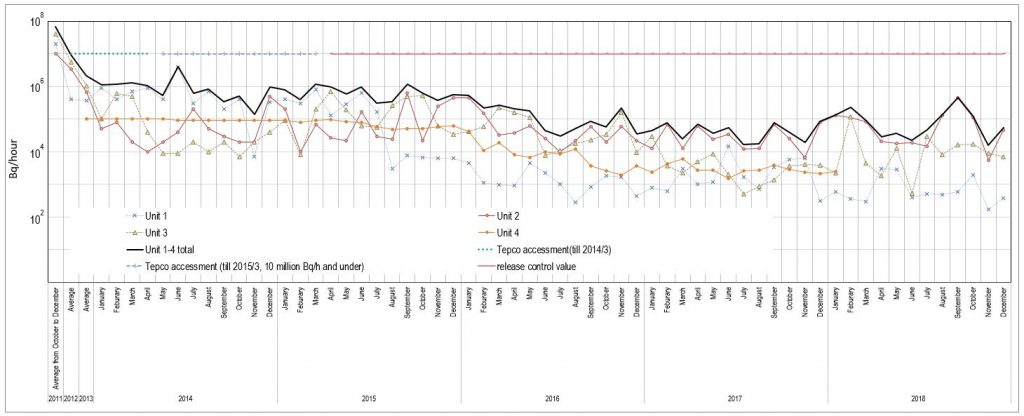Fukushima Now: Current State of Post-Accident Operations at Fukushima Daiichi Nuclear Power Station (Sep. 2018 to Jan. 2019)
by Matsukubo Hajime, CNIC
State of the Plant
From the water temperature in the containment vessels and the spent fuel pools (SPFs), and from the state of releases of Xenon-135, released when uranium fuel undergoes fission, and other measurements, it can be estimated that the state of the reactors is stable. Further, according to an assessment by TEPCO, around 50,000 bequerels per hour (Bq/h) of radioactive materials were being released from the buildings as of December 2018 (Fig.1). This figure was 470,000 Bq/h in September, the highest for release of radioactive materials since January 2016. TEPCO says that this was due to the work of removing remaining objects from the operating floor of Unit 2, and so on.
Figure 1. Releases of radioactivity from Units 1 to 4 of Fukushima Daiichi Nuclear Power Station (Bq/h)

The situation regarding the removal of spent fuel from the SPFs is summarized in Table 1. With the exception of Unit 4, from which spent fuel removal has been completed, all SPFs are currently undergoing pre-removal preparation work. Further, problems have occurred several times with the spent fuel removal equipment (fuel handling equipment crane and fuel-handling machine) in Unit 3, resulting in the start of spent fuel removal being postponed from the middle of FY2018 to the end of March 2019.
Table 1: State of Spent Fuel Pool Cleanup
| Unit 1 | Installation of a windbreak fence was completed after removal of building cover. Debris removal work is ongoing. |
| Unit 2 | Work on the removal of objects remaining on the operating floor has been completed and the state ofthe floor is now being investigated. |
| Unit 3 | Frequent problems with fuel-handling machine. Countermeasures were completed on Jan. 27, 2019. Start of fuel removal is planned for around end of March. |
| Unit 4 | Completed (December 22, 2014) |
In addition, the work (scheduled to begin in May 2019) to dismantle the upper section of the Unit 1&2 exhaust stack, in which a fracture was discovered in a supporting pillar, and the creation of a landfill (preparative work began in November 2018 and is scheduled for completion in FY2021) using the megafloat in which contaminated water was stored in 2011-12, as well as other tasks, are underway or in the pipeline.
State of Contaminated Water
Contaminated water countermeasures at Fukushima Daiichi Nuclear Power Station (FDNPS) can be broadly divided into three areas: 1) Reduction of groundwater flowing into buildings, 2) Reduction of contaminated water flowing into the sea, and 3) Reduction of the toxicity of contaminated water. Regarding the reduction of water volumes flowing into buildings, the main countermeasures are, from higher elevations downward, A) Pumping up groundwater at the ground water bypass and releasing it into the sea (442,560m3 up to January 29, 2019), B) Installation of a frozen earth barrier (on-land water barrier, total length roughly 1,500m) surrounding FDNPS Units 1-4. (Below ground temperature has now reached 0oC except for one section.) C) Pumping up water at the subdrains and releasing it into the sea (650,898m3 up to January 29, 2019), and D) Paving of the site with asphalt to suppress permeation of rainwater into the soil. Regarding reduction of contaminated water flowing into the sea, the countermeasures being taken include A) Groundwater leakage prevention by a steel water barrier on the sea side, B) Pumping up of groundwater dammed up behind the sea-side water barrier from the well points and groundwater drains. (197,239m3 up to January 29, 2019; as this groundwater is highly contaminated, it is being transferred to the turbine building), and other measures. Regarding the reduction of the toxicity of contaminated water, after removal of cesium and strontium and removal of impurities using reverse osmosis (RO), radionuclides except for tritium are removed by the multi-radionuclide removal equipment (ALPS – Advanced Liquid Processing System) and then stored in tanks (containing 994,865m3 as of January 31, 2019). Besides this, water remaining in buildings is roughly 38,350m3, strontium-treated water, etc. is 123,320m3, water treated by RO is 3,222m3, concentrated brine is 500m3, concentrated waste water is 9,230m3, etc.
Further, it was confirmed that hydrogen sulfide gas at or in excess of 50ppm was present in welded-type tanks storing strontium-treated water. TEPCO presumes that the gas is a product of the anaerobic decomposition of organic material by sulfate-reducing bacteria. As hydrogen sulfide is corrosive, one tank is to undergo internal inspection. There are frequent reports of industrial accidents involving hydrogen sulfide poisoning in anaerobic environments in manholes, tanks, etc. High concentrations of hydrogen sulfide are also known to be fatal, but TEPCO was using detectors that cannot measure above 50ppm.



